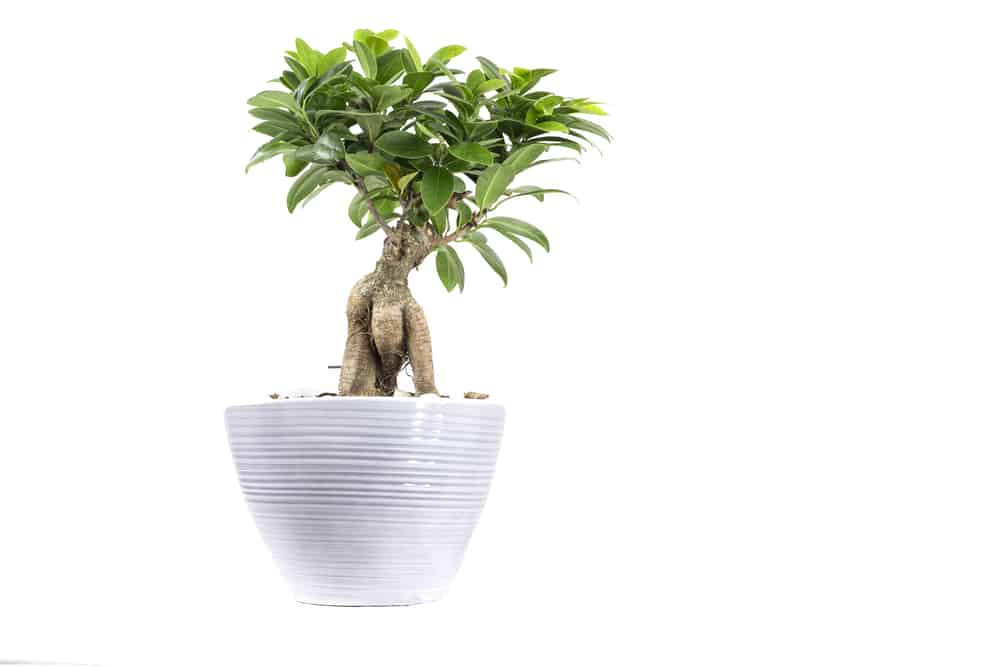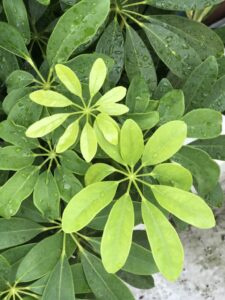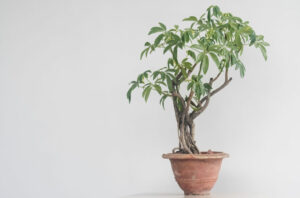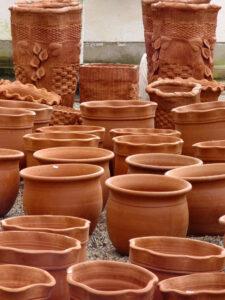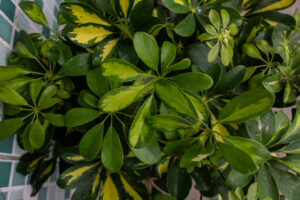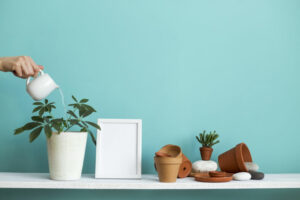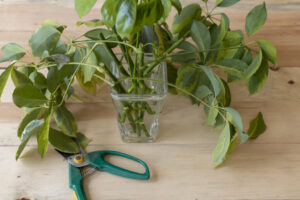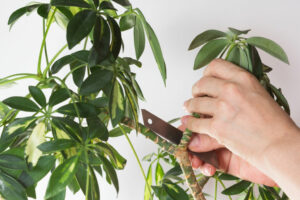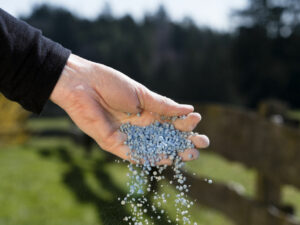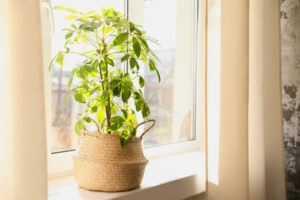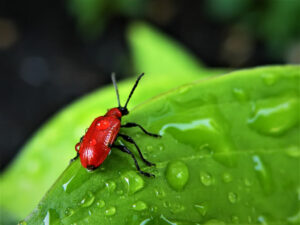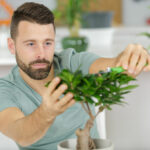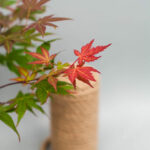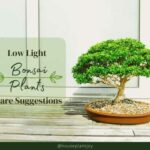HousePlantJoy is supported by our audience. When you purchase through one of our links, we may earn a small affiliate commission. As an Amazon Associate I earn from qualifying purchases. Your cost is not affected.
==================
Hawaiian Umbrella Bonsai Care
The Schefflera arboricola is known as the Hawaiian Umbrella Bonsai. Despite its name Hawaiian, the bonsai tree is native to Australia and Southeast Asia. Beginners in bonsai planting often choose this amazing bonsai.
The glossy, dark, and umbrella-shaped leaves form a dense canopy. Capturing the hearts of every bonsai lover.
What makes the Hawaiian umbrella plant unique? Is that it comes in dwarf version, making it ideal for bonsai training. Plus factor is its mangrove-like roots which you can cultivate as rock bonsai. This umbrella tree plant is not new in the market. In fact, due to its beautiful structure. Many bonsai lovers opt for umbrella bonsai. To know more about this amazing bonsai, continue reading!
Is Hawaiian Umbrella Bonsai Good For Beginners?
The answer is yes! Schefflera Arboricola possesses many qualities that make it for starting bonsai collectors. One thing about this umbrella bonsai is good for beginners. It is not sensitive to its environment. It can thrive with little care and even indoors in low light conditions. Hawaiian Umbrella Trees are not demanding about water conditions. Wrong watering is how most amateurs wind up causing damage to the bonsai tree. These trees are lenient up to one and don’t permit the dirt to dry out.
But, they do best in USDA zones 9-11. The vast majority live north of Florida, Texas, and California. Keep them inside all year with no issues. Umbrella tree bonsai enjoys the indoor area. Especially when placed in indirect lighting from east or west-bound windows.
What Are The Features Of the Hawaiian Umbrella?
The Hawaiian umbrella plant has the most beautiful features in the bonsai community. Its lustrous green leaves divide and produce orange-red to blackberries. The little leaves form together to resemble a spread-out umbrella. Making its form a green, thick and beautiful canopy. While for roots structure, the umbrella bonsai has a unique feature like a mangrove tree.
Furthermore, the trunk is thin and does not become a crown like some other subtropical plants. You’ll find it fruitful root exciting and very attractive once developed. The bonus point is it has a dwarf version that can grow about 5-inch to 8-inch tall in a 6-inch container. If you want to put it indoors, watering will not be a hassle.
What Kind Of Pot Does An Umbrella Plant Need?
Choosing the right pot for your umbrella bonsai is just as crucial as any aspect of bonsai care. Aside from picking based on its style, you should also consider if it’s a perfect fit for your bonsai plant. But using a relatively equivalent pot is recommended because the rootage can get larger over time. This is advisable for indoor bonsai and outdoors too. Suppose to give more room for the roots to grow instead of being contained. An overly large pot is a no because the roots will have a tough time retaining all the water. You can choose a pot about 2″-3″ bigger than the primary system.
Just a pro-tip, use a ceramic or porcelain pot. These are good for absorbing water without rotting the roots. Your pot needs an excellent drainage hole for your Hawaiian umbrella plant. You can drill your hole. If you’ve got a pot with no drainage hole, that would be perfect also. Try this example; if the roots are almost 2″ long, I might use a 4″ pot. If the roots were 4″ long, I might use a typical 6″ pot.
How To Make Schefflera Plant Bushy?
Do you want to make your Schefflera Arboricola appear bushy? Then pruning is the number one solution: cutting some branches to encourage new plant growth. Follow these easy steps to achieve a bushy Hawaiian umbrella bonsai in the comforts of your home.
- Make sure you have a healthy umbrella bonsai tree to begin the pruning.
- If your bonsai tree is becoming too large, start the pruning to invite more sunlight.
- Start by cutting the tips about 2.5 cm. also, remove the large leaves.
- Just leave the leaf stalk. It will eventually fall as they dry without damaging the Hawaiian umbrella bonsai.
- For younger shoots, you can train them through wiring Schefflera‘s shoots. Avoid the older branches. They are prone to breakage.
- After pruning and wiring your Hawaiian umbrella tree bonsai, let it recover for a few days.
How To Take Care Of A Hawaiian Umbrella Bonsai?
It’s fairly simple and not complicated to handle a Hawaiian umbrella bonsai. Unlike other bonsai trees, it can be hard to keep them alive. But this umbrella tree plant won’t require much from you as long as you know how to properly take good care of the Hawaiian umbrella plant. You’re going to do great. Here are some caring techniques you should note.
Umbrella Plant Water Requirements
When it comes to water, the Schefflera Arboricola is not very particular. But as long as you won’t let the soil be completely dry. Keeping the soil moist stimulates the root growth of the bonsai tree. Just a note when watering, make sure the water drains to the root system and from the bottom of the pot. And this prevents sal build-up.
For indoor conditions, it tends to dry to build the mugginess around the bonsai. Place the pot on top of a dampness plate loaded with stones and water. The vanishing water humidifies the encompassing air. You have to ensure that the water does not reach the bottom of the container; otherwise, the roots will start to rot. Avoid arid regions in your home close to radiators, heaters, and chimneys.
How do you propagate a Hawaiian umbrella bonsai?
Suppose you’re planning to multiply your Hawaiian umbrella plant to increase your plant bonsai collection. Then propagation will be your best option. You can either do it by water propagation or the plant cutting through its leaf. For water propagation, cut a healthy stem from the umbrella bonsai. Air dry it for a few days. After that, place it in a glass of water. Make sure to give it the right temperature, humidity, and light.
If you want to do plant cutting, you have to cliff off a stem at the bottom of the plant and wrap it with a damp towel. Start cutting each leaf in half horizontally to scale back the moisture it loses. Then put a 6-inch (15 cm.) container with fresh potting mud/soil on your newly Hawaiian umbrella tree. It is recommended to start from the seeds. Get a healthy seed, cover it with potting soil and mist regularly, then wait until it germinates.
Pruning of Hawaiian umbrella bonsai
Hawaiian Umbrella Bonsai is evergreen shrubs that are easily pruned to achieve your desired style. You need to understand that if you want to start cutting back your Schefflera Arboricola. No need to worry if you overdid the curtailing. Just use hand pruners to chop each of your plant’s tall stems back to a couple of inches. Before you create the cut, look carefully at the stem, and then cut a few half-inch above where a leaf is attached.
If you want to explore pruning, start by removing the overgrown bonsai tree tips. Also, get rid of large leaves, but leave the leaf stems because they will fall off themselves. It is just easy to learn bonsai techniques for shaping. Older trees will grow some called “air roots” if the humidity level is accurate. Which leads to its prominent look. Wiring is possible even when the branches are still green, but you have to be careful not to damage the bark. You’ll find a rock cling on your Schefflera. You might need a rock for the roots to wrap it all over. This makes it more beautiful to look at. But in Chinese traditions, having a rock cling to bonsai symbolizes yin and yang. It resembles the eternal quality of the universe.
Does A Hawaiian Umbrella Bonsai An Outdoor Or Indoor Plant?
If you are curious, the answer to this question is both. You can grow or put your umbrella tree plant if you prefer it indoors or outdoors. This Hawaiian umbrella tree can thrive in any environment. So, you do not need to worry about its placement. If you insist on putting it indoors, Hawaiian Schefflera prefers a temperature of 55°F to 75°F (13°C to 24°C). Look out for scale, insect, and coarse bugs when this tree is put inside.
If you let the Hawaiian umbrella tree grow outdoors, it will be grown year-round in USDA zones 10-11. Also, before planting this bonsai tree, check local restrictions. It can be an aggressive grower in Florida and Hawaii. So bee a responsible bonsai planter. Even though Schefflera Arboricola is resistant to vermin and sickness outside, keep your eye on bugs.
When Should I Repot My Umbrella Bonsai?
Umbrella tree bonsai also need repotting to accommodate the overgrown roots in a big pot. You need a very gentle hand in repotting your Schefflera. Its roots are prone to breakage. Gardeners recommend repotting umbrella bonsai every two years during springtime. Before you do this, remove the excess large leaves to give room for more energy to the bonsai plant. Once the Hawaiian umbrella bonsai settles into its new pot. It gets more beautiful and healthy.
Fertilizing Hawaiian Umbrella Bonsai
You have two choices: fertilize umbrella tree plant using liquid and solid fertilizer. For liquid fertilizer, apply weekly during the growing season and reduce to once a month. If the bonsai tree is grown. Solid fertilizer also works wonders, do this once a month. Be careful in pouring bonsai fertilizer that contains a high amount of nitrogen. This will lead to growing large leaves.
Temperature Requirement Of Hawaiian Umbrella Bonsai
As we know, Hawaiian umbrella bonsai is a subtropical bonsai plant. Its temperature ranges from 64 to 71 degrees. Be gradual in introducing it outside to adjust to the temperature change. For indoors, position umbrella bonsai near a heat source. It should never be in temperatures under 59 degrees.
Lighting For Hawaiin Umbrella Bonsai
Schefflera Aboricola is not sensitive when it comes to lighting. If you keep it indoors, place it in bright windows, but slightly dim places also work. Hawaiian umbrella tree bonsai needs the right amount of light and shade. The more light this plant receives, its leaves will be smaller, and its stem will be dense. With little to no light, the stems will become tall and thin and unsuitable for the look we want in a bonsai.
Hawaiian Umbrella Bonsai Pests And Diseases
Like any other bonsai plant, Hawaiian umbrella bonsai is not safe from pests and diseases. To prevent this, routinely check for insects and fungus. The bonsai’s hygiene plays a big factor in preventing forestalling bugs and sicknesses. You must know how to identify the types of pests on your houseplants. To know the proper solution or pesticides to use. To prevent fungus and molds, have a good draining pot and potting mix. You can buy over-the-counter pesticides. Formulating your own using 1 tsp dish soap to 1-quarter lukewarm water is encouraging. Spray it on the infected area of the umbrella bonsai. Do this until the pest and disease vanish.
Schefflera Plant’s Life Span
Your Schefflera Arboricola‘s life span depends on proper care. Also, meeting its desired living conditions. Experts even say that umbrella tree bonsai can live for more than a century that’s more than 100 years. Can you believe that? This bonsai tree can be your family heirloom. It will take 30 years for Hawaiian Schefflera to fully mature.
Conclusion
It has been known for well over 1,000 years. Bonsai growing is to make a scaled-down yet realistic portrayal of nature as a tree. Bonsai is not just one or two varieties of plants. Indeed, any tree species can be utilized to grow one. Some are just easier than others. There are hundreds of bonsai plants that exist. This Hawaiian umbrella bonsai takes first place in the bonsai community. Not just its dazzling beauty you’ll fall for but how it is easy to take care of.
So what are you waiting for? Consider Hawaiian Umbrella Bonsai to be part of your plant collection. Just follow our simple tips, and your tree will bring you a hundred years of enjoyment!
We are delighted to know our readers are enjoying our houseplant contents, especially the bonsai categories. Look for more loveable bonsai to be featured. According to our research, a FUKU Bonsai is coming out too. We’re excited to share Hawaiian Bonsai’s beautiful cousins in the bonsai world. As always, we’ll discuss it in detail one-by-one.
Read More
Indoor Bonsai Care

